Chapter Eight Forward Bending: Hip Flexion With Flat Lumbar Spine (Figures A-F) • To decrease low back flexibility • To increase hip joint flexibility • To improve ability to move in hips without excessive bending of the lumbar spine Starting position: Stand with feet spaced comfortably apart. Level 1: With hand support (see Figures A-D) Level 2: Without hand support (see Figures E-F) Forward Bending With Spinal and Hip Flexion (Figures A-B) Starting position: Stand with feet spaced comfortably apart. Return by contracting the gluteal muscles Move in the hip joints and move throughout the return to the erect position Lateral Spinal Flexion—Side-Bending Position (Figures A-C) • To increase the flexibility of the paraspinal muscles • To increase the flexibility of the abdominal muscles • To decrease the excessive flexibility of some spinal segments Stand with your back against a wall to avoid rotating Place your hands on the top of your head (see Figure A) Lean to the side (see Figure B) Think about TILTING your shoulders rather than moving from your waist; STOP if pain is experienced Return to an erect standing position Single-Leg Stance: Unilateral Hip and Knee Flexion (Figures A-D) • To improve the performance of the gluteal hip muscles • To improve the isometric control by the abdominal muscles • To prevent compensatory movements of the hip, pelvis, and spine Shift your weight to stance leg Tighten your buttock muscle on the side of your stance leg Lift your alternate thigh in front of your body while bending your knee Hip and Knee Extension With Contralateral Hip and Knee Maximally Flexed (Figures A-C) Starting position: Bend hips and knees; feet are on the floor. Place fingers on abdominal muscles (i.e., on outside of abdomen between pelvis and ribs) Contract your abdominal muscles by pulling your “navel toward your spine” Lift one knee toward your chest Use your hand to hold your knee to your chest If necessary, reinforce abdominal contraction Slide your other leg down, STOP if pain is experienced in your back STOP if pelvis tilts; return to the starting position Return by sliding your leg back to the starting position while contracting your abdominal muscles Hip and Knee Extension From Hip and Knee Flexion (Figures A-C) Starting position: Bend hips and knees; feet are on the floor. Place your fingers on your abdominal muscles (i.e., outside of abdomen between your pelvis and ribs) Contract your abdominal muscles by “pulling your navel toward your spine” Slide one leg down while keeping your pelvis from moving If you experience no pain, slide your alternate leg down Return by sliding one leg back at a time; make certain to contract your abdominal muscles Hip and Knee Flexion From Passive and Active Hip and Knee Extension (Figures A-C) • To increase hip flexion flexibility • To stretch the hip extensors (gluteus maximus and piriformis) • To improve the isometric control of the pelvis by the abdominal muscles STOP if you experience pain in your groin or back Hip and Knee Flexion With Sliding Heel From Hip and Knee Extension (Figures A-B) Place your hands on your abdominal muscles (i.e., outside of your abdomen between pelvis and ribs) Contract your abdominal muscles by “pulling your navel to your spine” Slide one foot along the table until your hip and knee are bent and your foot is resting on the table Contract your abdominal muscles Slide your foot down, returning it to the rest position Repeat the movement with your alternate leg Lower Abdominal Progression—Unilateral Hip Flexion (Figures A-B) To improve the performance of abdominal muscles (external obliques, rectus abdominis, transversus) To learn to prevent lumbar spine motions associated with leg motion Level 0.3: Lift one foot with alternate foot on floor Contract your abdominal muscles by “pulling your navel toward your spine” Maintain your abdominal contraction and lower your foot back to the table Lower Abdominal Progression—Hip and Knee Held to Chest During Hip Flexion (Figures A-B) • To improve the isometric performance of the abdominal muscles (e.g., external obliques, rectus abdominis, transversus) • To move the lower extremity without movement of the spine or pelvis Starting position: Bend hips and knees with feet on floor. Level 0.4: Hold knee to chest and lift the alternate foot Contract your abdominal muscles by “pulling your navel toward your spine” Lift one knee toward your chest Hold your knee toward your chest with your hand If able to hold your knee with one hand, place your alternate hand on the abdominal muscle (i.e., outside of abdomen between your pelvis and ribs) Make certain your abdominal muscles are contracted Lift your alternate foot off the table Lower your foot to the table while maintaining a contraction of your abdominal muscles Level 0.5: Lightly hold one knee toward chest and lift the alternate foot Lower Abdominal Progression—Hip and Knee Flexion With Alternate Foot Unsupported (Figures A-E) • To improve the performance of the abdominal muscles (e.g., external obliques, rectus abdominis, and transversus) Level 1A: Hip flexed to greater than 90 degrees and the alternate foot lifted (Figures A-C) Contract abdominal muscles by “pulling navel toward spine” Lift one foot off the floor and bring your knee toward your chest to more than 90 degrees If necessary, contract your abdominal muscles again Lift the alternate foot off the floor Lower your last leg lifted while maintaining the abdominal contraction Lower your alternate leg back to the starting position Level 1B: Hip flexed to 90 degrees and lift the alternate foot (Figures D-E) Contract abdominal muscles by “pulling navel toward spine” Lift one foot off the floor and stop when your hip is bent 90 degrees and your thigh is pointing toward ceiling If necessary, again contract your abdominal muscles Lift the alternate foot off the table Lower your last leg lifted so it returns to starting position Lower Abdominal Progression—Hip and Knee Extension (Figures A-D) • To improve the isometric performance of the abdominal muscles (e.g., external obliques, rectus abdominis, transversus) Contract abdominal muscles by “pulling your navel toward your spine” Lift one leg up until your hip is bent to 90 degrees and your thigh is pointing toward ceiling If necessary, reinforce the contraction of your abdominal muscles Do not let your abdomen distend Do not push your head back into supporting surface Lift your alternate foot off the table Slide your foot down the table, while lightly touching the table Straighten your leg completely Reinforce your abdominal contraction Slide your foot back to the starting position Lower Abdominal Progression: Bilateral Hip and Knee Flexion (Figures A-B) • To improve the performance of the abdominal muscles (e.g., external obliques, rectus abdominis, transversus) Starting position: Lie down with both hips and knees straight. Level 4: Slide both feet along the supporting surface into extension and return to flexion Contract your abdominal muscles by “pulling your abdomen toward your spine” Bend your hips and knees and slide your heels along the table Lift both feet off table when your hips are bent to 90 degrees Contract your abdominal muscles by “pulling your abdomen toward your spine” Bend your hips and knees by lifting both your feet off the table and bringing your knees to your chest Hold your hips at 90 degrees and straighten your knees Lower your legs to the table, returning to starting position Upper Abdominal Progression: Trunk Curl–Sit Up (Figures A-D) • To improve the performance of the upper abdominal muscles (e.g., internal obliques, rectus abdominis) Level 3: Trunk curl-sit up: spinal and hip flexion (most difficult) Place hands on top of head (not behind head) (see Figure D) Bring chin toward your the base of your neck Hip Abduction—Lateral Rotation From Flexion Position: Bent Knee Fallouts (Figures A-D) • To improve the isometric performance of the abdominal muscles in preventing pelvic rotation • To move the leg without moving the pelvis • To stretch the hip adductor muscles (e.g., inner thigh muscles) Contract your abdominal muscles by pulling “your navel toward your spine” Let your knee move toward, outside, and away from your body (see Figures B-C) Bring your knee back to the starting position Return to the starting position Repeat the movement ______ times Hip Abduction—Lateral Rotation From Flexion Position: Knee Extended (Figures A-D) Contract your abdominal muscles by “pulling your navel toward your spine” Let your knee move away from your body (see Figure B) From that position, straighten your knee (see Figure C) Try not to push down with your nonmoving leg Straight-Leg Raises: Hip Flexion With Knee Extended (Figures A-D) • To improve the performance of the abdominal muscles • To improve the performance of the hip flexor muscles Contract your abdominal muscles by “pulling your navel toward your spine” Raise your leg straight up while keeping your knee straight Do not push down with your nonmoving extremity Lower your leg back to the starting position while keeping your abdominal muscles contracted Two-Joint Hip Flexor Stretch (Figures A-E) • To stretch the hip flexors (e.g., tensor fascia lata, rectus femoris, iliopsoas) • To prevent compensatory anterior pelvic tilt or rotation
Exercises to Correct Movement Impairment Syndromes
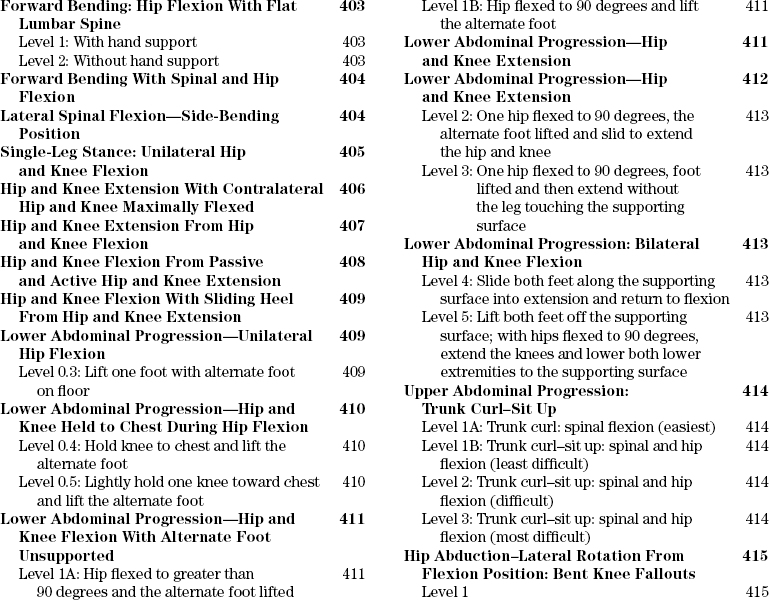
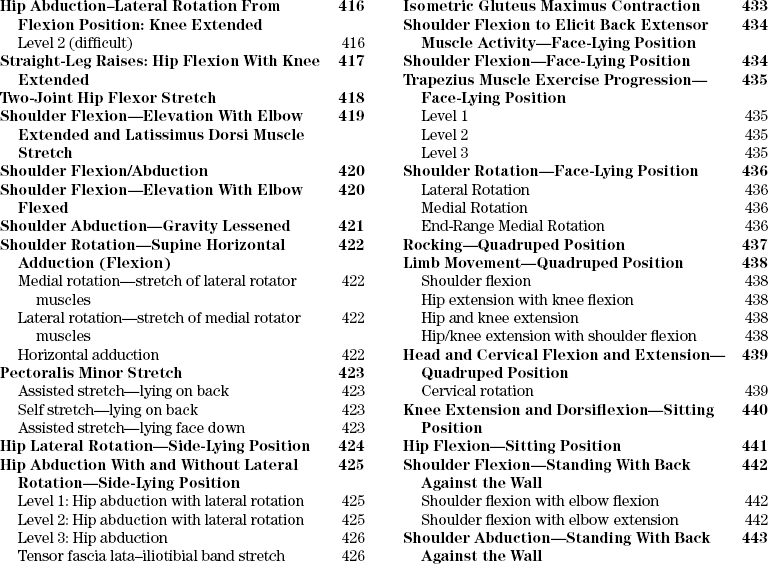
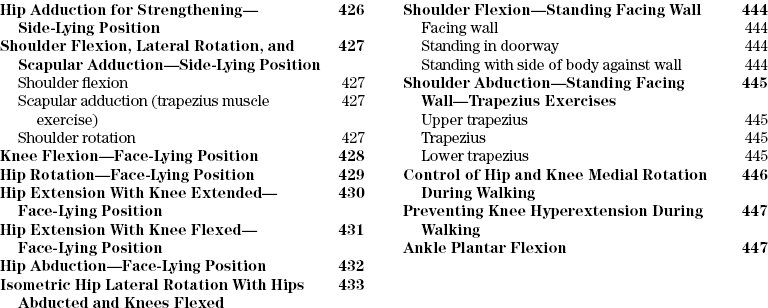

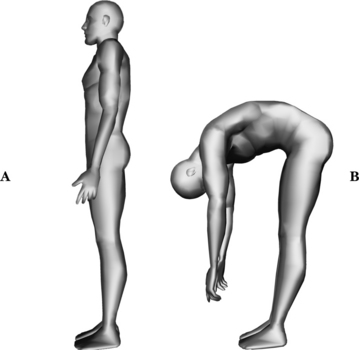
 Perform variation if box is checked
Perform variation if box is checked
 Let your upper and lower back bend as you bend forward
Let your upper and lower back bend as you bend forward
 Try to bend in just your low back as you bend forward
Try to bend in just your low back as you bend forward
 Contract your abdominal muscles as you bend forward
Contract your abdominal muscles as you bend forward
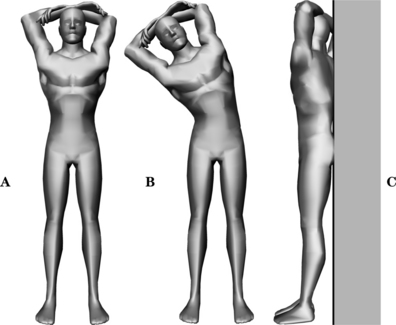
 Perform variation if box is checked
Perform variation if box is checked
 Take a deep breath and lift your chest
Take a deep breath and lift your chest
 Place your hand on your side at waist level and continue as before
Place your hand on your side at waist level and continue as before
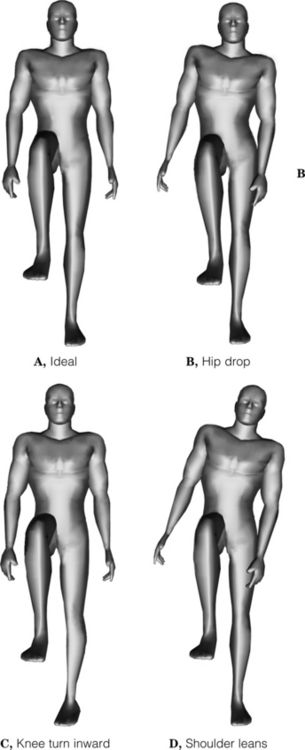
 Perform variation if box is checked
Perform variation if box is checked
 Contract your abdominal muscles
Contract your abdominal muscles
 Place your hands on your pelvis to monitor your movement
Place your hands on your pelvis to monitor your movement
 Do not let your opposite hip drop (see Figure B)
Do not let your opposite hip drop (see Figure B)
 Do not let your knee turn inward (see Figure C)
Do not let your knee turn inward (see Figure C)
 Do not let your shoulders lean to the side (see Figure D); keep your trunk still
Do not let your shoulders lean to the side (see Figure D); keep your trunk still
 Do not let your ankle pronate (i.e., arch collapsed or turned in)
Do not let your ankle pronate (i.e., arch collapsed or turned in)
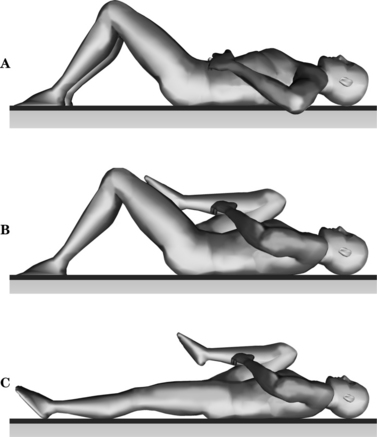
 Perform variation if box is checked
Perform variation if box is checked
 Slide your leg down, while contracting your abdominal muscles
Slide your leg down, while contracting your abdominal muscles
 Place your hand on your pelvis; and prevent forward tilting movement of your pelvis
Place your hand on your pelvis; and prevent forward tilting movement of your pelvis
 Slide your leg out to side; with repetitions, bring your leg in toward your other leg
Slide your leg out to side; with repetitions, bring your leg in toward your other leg

 Perform variation if box is checked
Perform variation if box is checked
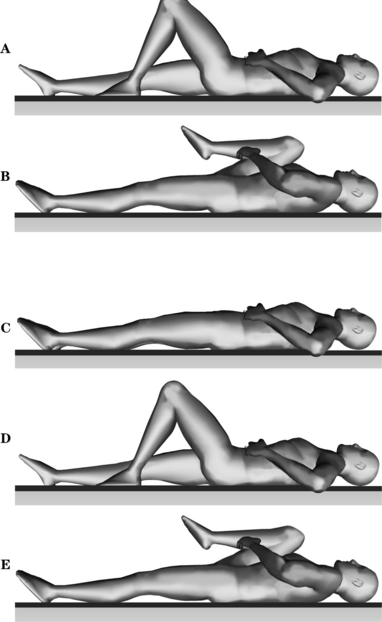
 Use ____ hand(s) or ____ towel(s) under thigh to pull knee to chest
Use ____ hand(s) or ____ towel(s) under thigh to pull knee to chest
 Be sure to relax the hip muscles as you pull your knee to your chest
Be sure to relax the hip muscles as you pull your knee to your chest
 Place a towel with a few folds under your low back
Place a towel with a few folds under your low back
 Lower your leg so that your foot is on the table and your hip and knee are still bent
Lower your leg so that your foot is on the table and your hip and knee are still bent
 Repeat with the same leg ______ times
Repeat with the same leg ______ times
 Perform with your alternate leg as above ______ times
Perform with your alternate leg as above ______ times
 Contract your abdominal muscles by pulling “your navel toward your spine”
Contract your abdominal muscles by pulling “your navel toward your spine”
 Slide your foot along a table to bend your hip and knee and place your foot on table
Slide your foot along a table to bend your hip and knee and place your foot on table
 Use your hip muscles to bring your knee to your chest
Use your hip muscles to bring your knee to your chest
 Use your hands to pull your knee to your chest when your thigh is vertical or your hip is at 90 degrees
Use your hands to pull your knee to your chest when your thigh is vertical or your hip is at 90 degrees
 Do not push down with your alternate leg
Do not push down with your alternate leg
 Lower leg and return to starting position
Lower leg and return to starting position
 Return your leg to the starting position
Return your leg to the starting position
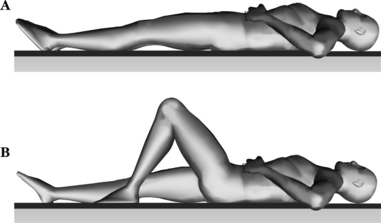
 Perform variation if box is checked
Perform variation if box is checked
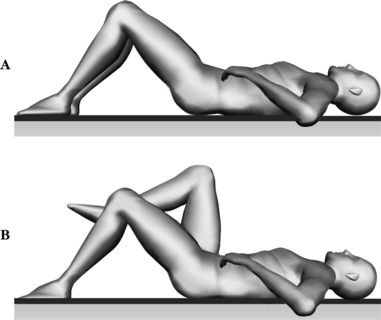
 Perform variation if box is checked
Perform variation if box is checked
 If pain is experienced, push down into table with one foot, while lifting the alternate foot off the table
If pain is experienced, push down into table with one foot, while lifting the alternate foot off the table
 Use a pillow under upper back and head
Use a pillow under upper back and head
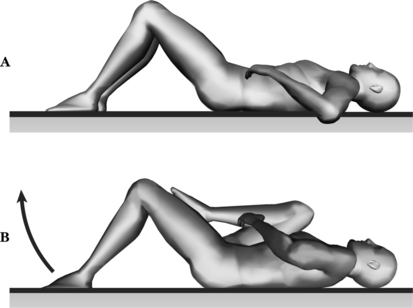
 Start if no pain is experienced when performing previous level 10 times
Start if no pain is experienced when performing previous level 10 times
 Do not hold your knee toward your chest as tightly as previously while lifting your leg off table
Do not hold your knee toward your chest as tightly as previously while lifting your leg off table
 Let your knee move away from your chest and hold it lightly with your hand while lifting your leg off the table
Let your knee move away from your chest and hold it lightly with your hand while lifting your leg off the table

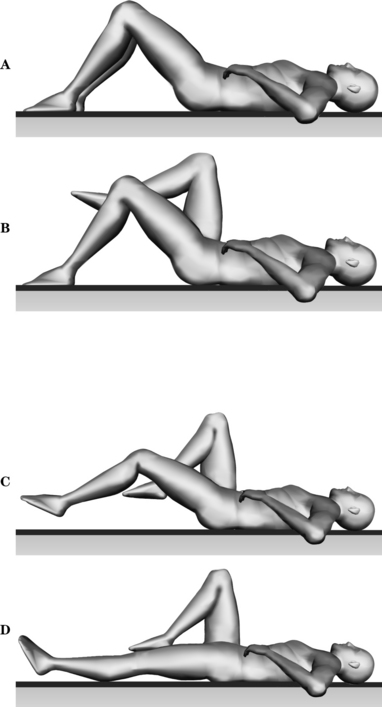
 Perform variation if box is checked
Perform variation if box is checked
 Lower your nonmoving leg to table, so both feet are on table
Lower your nonmoving leg to table, so both feet are on table
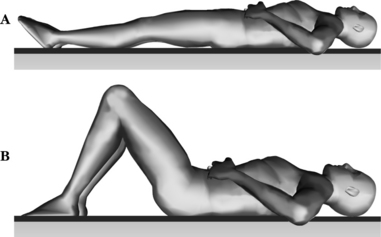
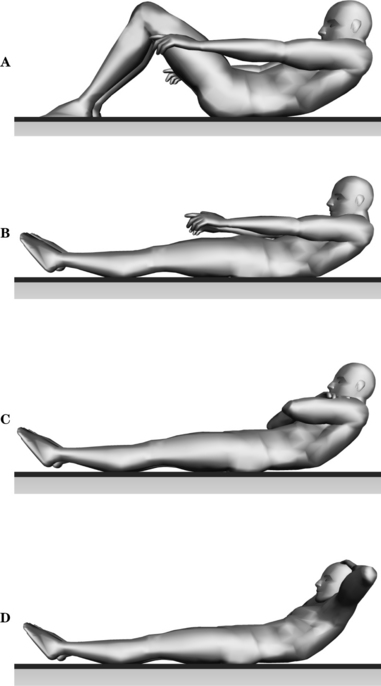
 Perform variation if box is checked
Perform variation if box is checked
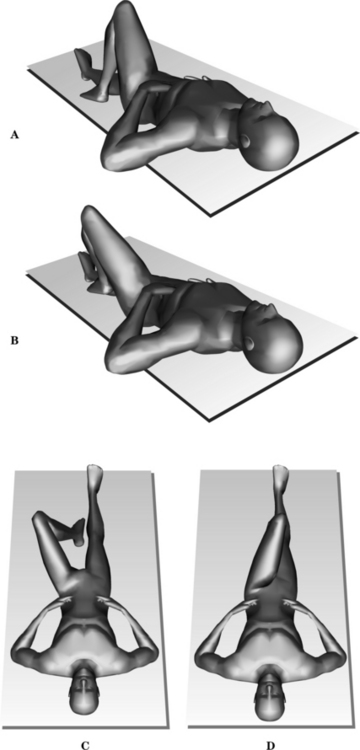
 Perform variation if box is checked
Perform variation if box is checked
 Bring your knee toward the inside of your body toward your opposite leg (see Figure D)
Bring your knee toward the inside of your body toward your opposite leg (see Figure D)
 Place pillow under the knee of the leg that is straight
Place pillow under the knee of the leg that is straight
 Place a pillow along side the leg that is bent at the level of the knee
Place a pillow along side the leg that is bent at the level of the knee
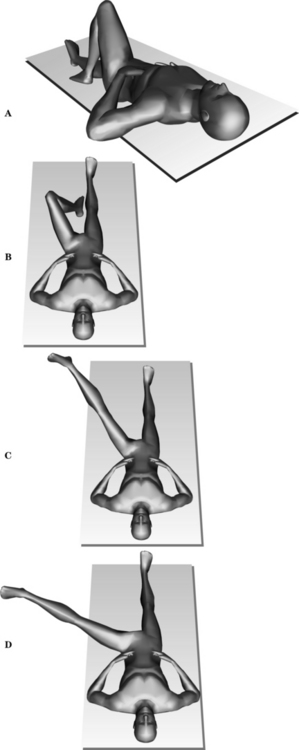
 Perform variation if box is checked
Perform variation if box is checked
 Return to the starting position
Return to the starting position
 Repeat straightening and bending your knee while maintaining this position of your leg ______ times
Repeat straightening and bending your knee while maintaining this position of your leg ______ times
 Return to the starting position
Return to the starting position
 Straighten your knee, keep your knee straight, and bring your leg toward opposite shoulder by moving at hip (see Figure D)
Straighten your knee, keep your knee straight, and bring your leg toward opposite shoulder by moving at hip (see Figure D)
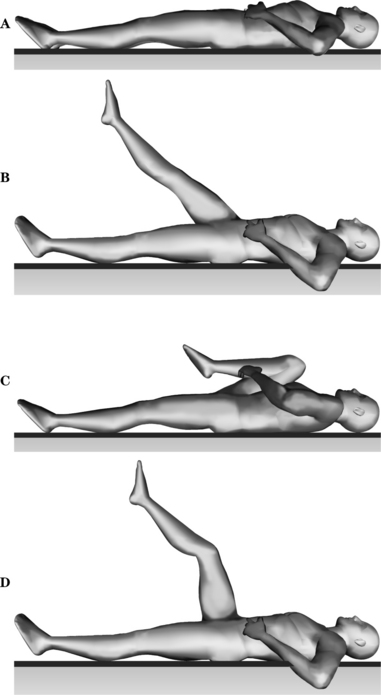
 Perform variation if box is checked
Perform variation if box is checked
 Bend your hip and knee, bringing your knee toward your chest (see Figure C)
Bend your hip and knee, bringing your knee toward your chest (see Figure C)
 Straighten your knee while keeping your hip at 90 degrees (i.e., thigh pointing toward ceiling) (see Figure D)
Straighten your knee while keeping your hip at 90 degrees (i.e., thigh pointing toward ceiling) (see Figure D)
 Hold your thigh with your hand, while straightening your knee
Hold your thigh with your hand, while straightening your knee
 Keep your knee straight and lower your leg back to the starting position
Keep your knee straight and lower your leg back to the starting position

Related
Related posts:
![]()
Stay updated, free articles. Join our Telegram channel

Full access? Get Clinical Tree


























